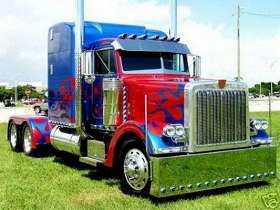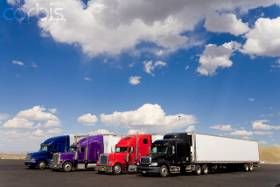How Many Traffic Accidents Do You Pass By On The Road?
Topic 942 | Page 2

Also, looking at the "Comparison of Certain Variables in the Large Truck Crash Causation Study" in the 'Other Reports' section, the majority of accidents seem to occur when trucks are travelling straight, with another motor vehicle in the lane, or encroaching it. So the biggest problem out on the road is probably our failure to maintain enough of a following distance for anticipating these problems. I rarely see trucks with a good following distance behind each other or other vehicles, and do not understand how so many truck drivers fail to get this critical aspect right.
OWI:
Operating While Intoxicated

Oh yeah, I guess that kind of damage adds up.
Well, it looks like the most lethal vehicle configuration between 2004-2008 was a tractor with one semi-trailer. Two trailers decreases the stat by about 90%. Not sure if that is mostly due to the number of each on the road though. There are generally fewer driver fatalities in tanker trucks than flatbeds, and more in vans than either of those.
Okay, I found a Vehicle Inventory and Use Survey, which indicates that there were about 90% more single units in use for 2002 (after which the survey was discontinued). So I suppose the accident statistics mostly reflect how many of each truck combination is on the road, instead of one being more dangerous than another.
HOS:
Hours Of Service
HOS refers to the logbook hours of service regulations.
So what did I learn in school today? Drive whatever you want, but whatever else you do, don't follow another vehicle too closely. Know your minimum stopping distances.
Also check out the Heavy Truck Research site, which provides reports on crash avoidance.

Yup...the bottom line for all drivers in any kind of truck is A. be aware of whats around you B. Watch your following distance, if 4 wheelers pass you and fill up your safe following zone, slow down and get another one. C. remember that in ANY truck trailer combo, panic brake application is gonna be bad.
And one of the most important things that is seldom mentioned, in or out of CDL school....the difference in the front of trucks when it comes to forward movement wrecks. We always had trucks with a big Texas Bumper. Why you ask ?? well, they really look good...But for me, its ta safety factor. If you for any reason end up hitting something(like a car) with the front of your truck, those Texas bumpers are worth their weight in gold. With a common truck with all the plastic up front, when you hit a car, all the plastic shatters, leaving you running OVER the car. With a truck wearing a Texas bumper, when you hit a car, it pushes the car...you won't ever run up and over it. For me, atleast, its a safety thing. I have never in my 47 years of driving things that moved, have never had an accident involving another vehicle. I'd rather push a car until we stopped, than hit it, have my plastic front end disintegrate, then run right up over the car. The damage isn't as bad, and those Texas bumpers have saved alot of lives thru the years...just food for thought.....companies don't like them because they are a little heavy, where plastic is cheaper and lighter.
CDL:
Commercial Driver's License (CDL)
A CDL is required to drive any of the following vehicles:
- Any combination of vehicles with a gross combined weight rating (GCWR) of 26,001 or more pounds, providing the gross vehicle weight rating (GVWR) of the vehicle being towed is in excess of 10,000 pounds.
- Any single vehicle with a GVWR of 26,001 or more pounds, or any such vehicle towing another not in excess of 10,000 pounds.
- Any vehicle, regardless of size, designed to transport 16 or more persons, including the driver.
- Any vehicle required by federal regulations to be placarded while transporting hazardous materials.
HOS:
Hours Of Service
HOS refers to the logbook hours of service regulations.OWI:
Operating While Intoxicated

So that's like the one in my avatar picture. I thought it was just for show. Makes sense now, it is odd that the rear "DOT bumper" (a.k.a., Jayne "Mansfield bar") was required for underride protection, while the same is not true of the front. I guess someone else in hollywood has to be killed before it occurs to the general public.
DOT:
Department Of Transportation
A department of the federal executive branch responsible for the national highways and for railroad and airline safety. It also manages Amtrak, the national railroad system, and the Coast Guard.
State and Federal DOT Officers are responsible for commercial vehicle enforcement. "The truck police" you could call them.
In my opinion, following distance is the #1 most important safe-driving factor. When you have plenty of time to react, your chances of avoiding a wreck are profoundly greater.
I can't remember the exact stat anymore, but years ago our safety department released a newsletter that said something like 70% of all multi-vehicle accidents could have been avoided if one of the drivers had 1/2 second longer to react.
Another key factor is trying to keep an opening to the side of you - either on the shoulder or another lane of traffic. You want to try to avoid having people ride alongside of you. You need an escape if something goes wrong in front of you and you won't have time to stop before reaching it.
OWI:
Operating While Intoxicated

Well, I don't know how many accidents I have seen since I have been driving. I never counted.
I remember the accident in Illinois that involved a rig and a motorcycle. I remember seeing a roll over on I-80 in Iowa, a truck stopped on I-40 in Arkansas. I have seen a few trucks in the median, especially over the winter. I saw a rig in the median last week in Kansas, with a guard rail disintegrated and a fire off a shoulder in the ditch.
I think I see one bad accident, involving a rig about once per month. At least once a week, traffic comes to a crawl because of some sort of accident, but by the time I get there, it is usually gone.
Dave

The only thing I worry about on following distance is if the company will monitor my speed and get on my case to drive faster. You can't have it both ways though.
OWI:
Operating While Intoxicated

The only thing I worry about on following distance is if the company will monitor my speed and get on my case to drive faster. You can't have it both ways though.
I don't care if the speed limit is 105 mph.if In order to keep a safe following distance can only 60 mph then so be it. One rear end accident can ruin your career. Never let anyone pressure you into being unsafe. If you company is pressuring you to drive faster and you do and have an accident then its totally your fault.
OWI:
Operating While Intoxicated
New Reply:
New! Check out our help videos for a better understanding of our forum features

















Preview:
This topic has the following tags:
Life On The Road Safe Driving Tips Truck Driving Stories







 TT On Facebook
TT On Facebook
Oh yeah, I guess that kind of damage adds up.
Well, it looks like the most lethal vehicle configuration between 2004-2008 was a tractor with one semi-trailer. Two trailers decreases the stat by about 90%. Not sure if that is mostly due to the number of each on the road though. There are generally fewer driver fatalities in tanker trucks than flatbeds, and more in vans than either of those.
HOS:
Hours Of Service
HOS refers to the logbook hours of service regulations.